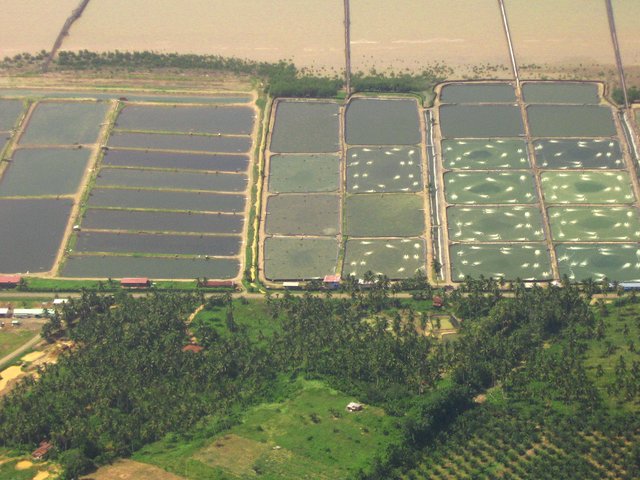Twenty-two feed producers are registered with the Department of Fisheries. The transportation of live feeds including polychaete worms fed to broodstock shrimp is thought to have resulted in the spread of AHPND across the Asia region.

Make The World A Better Place Part 4 Thailand S Dirty Shrimp Industry And Its Vicious Cycle Steemit
In Malaysia Thailand and Vietnam live polychaetes have indeed been confirmed as the infection source of Vp during AHPND disease outbreaks.

What is fed in shrimp farms in thailand. I am glad to welcome Best Aquaculture Partners to the ASC programme said Chris Ninnes CEO of. The shrimps are fed daily with high protein formulated diet. Most shrimp farming about 75 percent of the worlds shrimp is produced in Asia especially in Thailand and China.
Best Aquaculture Partners has become the first shrimp farm to gain ASC certification in Thailand. Catches there have dropped to 14 percent of levels a few decades ago and most of whats caught consists of small trash fish that are sold to companies that make the fishmeal fed to farmed Thai shrimp. There are also about 50 to 100 companies that supply farm.
Most shrimp farms in Thailand use high-quality high-protein feed. Is the latest company to earn three-star Best Aquaculture Practices BAP status with the BAP certification of its Somrak shrimp hatchery in Thailand. Farmed shrimp production in 2018 consisted of 827 L.
The creation of shrimp farms has a huge negative effect on the environment. Finally Thailands products are generally cleaner than other COOs. March 25 2016.
Its standards rely heavily on MSC for wild shrimp and it maintains its own farmed shrimp standards which ban antibiotics and preservatives and prohibit conversion of sensitive ecosystems such as mangrove forests into shrimp farms and we track the shrimp from pond to store to ensure the standards are met Many consider its standards to be the best in the. It has been estimated that 75 of farmed shrimp come from these Asiatic countries such as Thailand and China. The farm is located in the Suratthanee province and has been assessed by Control Union Peru CUP an internationally accredited conformity assessment body.
Monodon much of which was not feed based and 19 other or unidentified penaeids. Good Luck Products Co. Only a few species of shrimp are.
By 2003 the shrimp farm industry had rapidly expanded and was able to produce over 16 million tonnes that was worth over USD 9 Billion. In order to profit in the face of the plummeting catches boat owners kept cutting. There are a few different things you should consider when trying to determine which shrimp is better.
Our results suggest that little progress has been made in improving N utilization efficiency of intensive P. Monodon shrimp farming over the past decade. Vannamei feed would be around 5 fishmeal and 2 fish oil because L.
The other 25 are produced in Latin American countries such as Brazil Mexico and Ecuador. The World Wildlife Fund estimates that even a 1 percent global reduction in the feed conversion ratio for shrimp would save more than 261000. The remainder of the farms are.
Farm raised shrimp are fed antibiotics to help control illness. Stocking density ranges from 200250 per m 2 and average production ranges from 15 to 3 tons per crop in 1000 ton tank and about 1020 tonshayear in earthen ponds with concrete dikes. In addition the farm raised tanks are treated with chemicals to control bacteria and fungi.
Farming has made shrimp more accessible to an eager shrimp-loving public in the U. A vast majority of the shrimp farms in the world exist in Asia. Its ice made from water often found to be contaminated with bacteria and unfit for.
Vannamei makes up most of the production and almost entirely in ponds with feeding. The percentage of total N recovered as harvested shrimp in the present study 22 was very close to the 21 obtained in a previous study of intensive shrimp farms in Thailand Briggs and Funge-Smith 1994. Shrimp farming has come a long way from small-scale farms in Asia and Thailand to a global industry.
Thailands slavery problem was caused by rampant uncontrolled overfishing. These mangroves are destroyed to make way for shrimp ponds but the destruction of mangrove forests releases massive amounts of. Thai processors are able to produce high volumes of product including raw cooked and value-added shrimp.
Most shrimp aquaculture occurs in China followed by Thailand Indonesia India Vietnam Brazil Ecuador and Bangladesh and it has generated substantial income in these developing countries. Three-star BAP status denotes that a product originates from BAP-certified processing plant farm and hatchery or feed mill. Farmed shrimp accounts for 55 percent of the shrimp produced globally.
The shrimp at some plants are packed in ice. The reason why Indonesia has to date managed to prevent. The annual feed consumption is estimated to be about 900000 tons for the production of 600000 tons with an average feed conversion ratio of about 15.
Some 50 to 60 percent of the farmed shrimp from Southeast Asia and Central America comes from areas that used to be mangrove forests via Oceana.

Seafood Media Group Worldnews Important Growth In Shrimp Exports To China

Shrimp Farm In Thailand Stock Image Image Of Water Pond 83167505
